(VOVworld) – Mechanical engineering is a fundamental industry in Vietnam’s industrialization and modernization process which has received special attention from the government, particularly in increasing the localization ratio. Since the development strategy for Vietnam’s mechanical engineering industry was implemented a decade ago, the sector has gained encouraging achievements.
Manufacturing mechanics is recognized as the most outstanding achievement of Vietnam’s mechanical engineering, resulting in a steady increase in exports and improved competitiveness in both domestic and foreign markets. Last year the sector’s production totaled nearly 12 billion USD, 7 times the production in 2000. At the same time it earned more than 13 billion USD from exporting mechanical products making the industry one of Vietnam’s top exporters.

Workers of the Lilama 45-1, a subsidiary of the Vietnam Machinery Installation Corporation, are installing equipment for the first phase of Vina Kraft Paper Factory (Photo: Viet Binh)
|
In recent years a number of Vietnamese mechanical engineering enterprises have tried to sign engineering, procurement, and construction contracts for industrial projects worth 1 billion USD, and have joined ventures with other domestic partners to manufacture hydro-mechanical equipment for large hydroelectric plants. The Vietnam National Oil and Gas Group recently put into operation a 90-meter jack-up drilling rig made by the PetroVietnam Marine Shipyard Company, a breakthrough for the sector.
 |
| Vietnam’s mechanical engineering has only met 32% of the domestic demand. (Photo: Kim Thanh) |
The industry’s trade gap remains high, with imports doubling exports. The localization ratio is 32% against a target of 50%. The short fall is due to slow development of the auxiliary industry, investors who prefer foreign contractors, and difficulty in borrowing capital. Phan Tu Giang, Director of the Oil and Gas Drilling Rig Manufacturer, also blames poor coordination among enterprises leading to weak competitiveness. He added: “although ministries and agencies have devised many macro economic policies, they haven’t been coordinated. To penetrate the international market in the shortest time, mechanical engineering needs strategic support from the government, ministries, and specifically the oil and gas sector to decide on the use of domestically made oil rigs for Vietnam’s oil and gas projects.”
In the future, the Ministry of Trade and Industry will submit to government mechanisms to create better conditions for the sector to develop with a focus on raising the localization ratio, policies to encourage mechanical enterprises to improve coordination, investment cooperation, and technology renovation to turn out qualified products. Nguyen Chi Sang, Director of the Institute for Mechanical Engineering Research, said: “the government should encourage the sector by creating mechanisms to protect the industry. The government should have a coordinated development strategy for all industries, including mechanical engineering. For instance, our law on bidding should incentivize made-in-Vietnam products which can be used for state projects. This way we will not violate international bidding laws or WTO commitments.”
On June 18th, 2014, the Prime Minister issued an instruction to remove difficulties and promote a strategy for developing Vietnam’s Mechanical Engineering Sector. Mechanical businesses are now required to focus their investment in key projects and auxiliary industry projects, to renovate their cost management methods, and to improve their product quality and competitiveness. The Prime Minister also